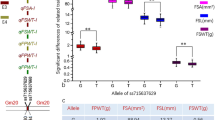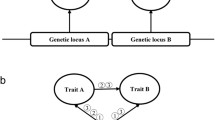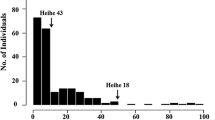Abstract
Pod dehiscence (PD) prior to harvest results in serious yield loss in soybean. Two linkage maps with simple sequence repeat (SSR) markers were independently constructed using recombinant inbred lines (RILs) developed from Keunolkong (pod-dehiscent) × Sinpaldalkong (pod-indehiscent) and Keunolkong × Iksan 10 (pod-indehiscent). These soybean RIL populations were used to identify quantitative trait loci (QTLs) conditioning resistance to PD. While a single major QTL on linkage group (LG) J explained 46% of phenotypic variation in PD in the Keunolkong × Sinpaldalkong population with four minor QTLs, three minor QTLs were identified in the Keunolkong × Iksan 10 population. Although these two populations share the pod dehiscent parent, no common QTL has been identified. In addition, epistatic interactions among three marker loci partially explained phenotypic variation in PD in both populations. The result of this study indicates that different breeding strategies will be required for PD depending on genetic background.




Similar content being viewed by others
References
Bailey MA, Mian MAR, Carter TE Jr, Ashley DA, Boerma HR (1997) Pod dehiscence of soybean: identification of quantitative trait loci. J Hered 88:152–154
Cai CM, Van K, Lee S-H (2007) Gene duplications revealed during the process of SNP discovery in soybean [Glycine max (L.) Merr.]. J Crop Sci Biotechnol 10:237–242
Caviness CE (1969) Heritability of pod dehiscence and its association with some agronomic characters in soybean. Crop Sci 9:207–209
Choi I-Y, Hyten DL, Matukumalli LK, Song Q, Chaky JM, Quigley CV, Chase K, Lark KG, Reiter RS, Yoon M-S, Hwang E-Y, Yi S-I, Young ND, Shoemaker RC, van Tassell CP, Specht JE, Cregan PB (2007) A soybean transcript map: gene distribution, haplotype and single-nucleotide polymorphism analysis. Genetics 176:685–696
Christiansen LC, Dal Degan F, Ulvskov P, Borhardt B (2002) Examination of the dehiscence zone in soybean pods and isolation of a dehiscence-related endopolygalacturonase gene. Plant Cell Environ 25:475–490
Chung J, Babka HL, Graef GL, Staswick PE, Lee DJ, Cregan PB, Shoemaker RC, Specht JE (2003) The seed protein, oil and yield QTL on soybean linkage group I. Crop Sci 43:1053–1067
Condibido VC, La Valee B, Mclaird P, Pineda N, Meyer J, Hummel L, Yang J, Wu K, Delannay X (2003) Introgression of a quantitative trait locus for yield from Glycine soja into commercial soybean cultivars. Theor Appl Genet 106:575–582
Cregan PB, Jarvik T, Bush AL, Shoemaker RC, Lark KG, Kahler AL, Kaya N, VanToai TT, Lohnes DG, Chung J, Specht JE (1999) An integrated genetic linkage map of the soybean genome. Crop Sci 39:1464–1490
Esau K (1997) Anatomy of seed plants. Wiley, New York
Funatsuki H, Ishimoto M, Tsuji H, Kawaguchi K, Hajika M, Fujino K (2006) Simple sequence repeat markers linked to a major QTL controlling pod shattering in soybean. Plant Breed 125:195–197
Gepts P (2004) Crop domestication as a long-term selection experiment. Plant Breed Rev 24:1–44
Haldane JBS (1919) The combination of linkage values and the calculation of distance between the loci of linked factors. J Genet 8:299–309
Halvankat GB, Patil VP (1994) Inheritance and linkage studies in soybean. Indian J Genet Plant Breed 54:216–224
Hancock JF (2004) Plant evolution and the origin of crop species. CAB International, Wallingford
Harlan JR, de Wet JMJ, Glen Price E (1973) Comparative evolution of cereals. Evolution 27:311–325
Hong EH, Kim SD, Lee YH, Hwang YH, Moon YH, Kim HS, Park EH, Seong YG, Kim YH, Kim WH, Ryu YH, ParK RK (1992) A good quality, semi-dwarf, high density-adaptable and high yielding new soybean variety “Sinpaldalkong”. RDA J Agric Sci 34:20–25
Hyten DL, Song Q, Zhu Y, Choi I-Y, Nelson RL, Costa JM, Specht JE, Shoemaker RC, Cregan PB (2006) Impact of genetic bottlenecks on soybean genome diversity. Proc Natl Acad Sci USA 103:16666–16671
Kang ST, Kim HK, Baek IY, Chung MG, Han WY, Shin DC, Lee S-H (2005) Genetic analysis of pod dehiscence in soybean. Korean J Crop Sci 50:281–285
Keim P, Olson TC, Shoemaker RC (1988) A rapid protocol for isolating soybean DNA. Soybean Genet Newsl 15:150–154
Koinange EMK, Singh SP, Gepts P (1996) Genetic control of the domestication syndrome in common bean. Crop Sci 36:1037–1045
Konishi S, Izaw T, Lin SY, Ebana K, Fukuta Y, Sasaki T, Yano M (2006) An SNP caused loss of seed shattering during rice domestication. Science 312:1392–1396
Lande R (1992) Plant breeding in the 1990s. CAB International, Wallingford
Lark KG, Chase K, Adler F, Mansur LM, Orf JH (1995) Interactions between quantitative trait loci in soybean in which trait variation at one locus is conditional upon a specific allele at another. Proc Natl Acad Sci USA 92:4656–4660
Lee SH, Bailey MA, Mian MAR, Carter TE Jr, Shipe ER, Ashley DA, Parrott WA, Hussey RS, Boerma HR (1996) RFLP loci associated with soybean seed protein and oil content across populations and locations. Theor Appl Genet 93:649–657
Li Z, Jakkula L, Hussey RS, Tamulonis JP, Boerma HR (2001) SSR mapping and confirmation of the QTL from PI96354 conditioning soybean resistance to southern root-knot nematode. Theor Appl Genet 103:1167–1173
Li C, Zhou A, Sang T (2006) Rice domestication by reducing shattering. Science 311:1936–1939
Mainly KF, Olson JM (1999) Overview of QTL mapping software and introduction to Map Manager QT. Mamm Genome 10:327–334
Njiti VN, Meksem K, Iqbal MJ, Johnson JE, Kassem MA, Zobrist KF, Kilo VY, Lightfoot DA (2002) Common loci underlie field resistance to soybean sudden death syndrome in Forrest, Pyramid, Essex, and Douglas. Theor Appl Genet 104:294–300
Orf JH, Chase K, Adler FR, Mansur LM, Lark KG (1999) Genetics of soybean agronomic trait: II. Interactions between yield quantitative trait loci in soybean. Crop Sci 39:1652–1657
Saxe LA, Clark C, Lin SF, Lumpkin TA (1996) Mapping the pod shattering trait in soybean. Soybean Genet Newsl 23:250–253
Schuster I, Abdelnoor RV, Marin SRR, Carvalho VP, Kiihl RAS, Silva JFV, Sediyama CS, Barros EG, Moreira MA (2001) Identification of a new major QTL associated with resistance to soybean cyst nematode (Heterodera glycines). Theor Appl Genet 102:91–96
Shoemaker RC, Olson TC (1993) Molecular linkage map of soybean (Glycine max (L.) Merr.). Cold Spring Harbor Laboratory Press, Cold Spring Harbor
Song QJ, Marek LF, Shoemaker RC, Lark KG, Concibido VC, Delannay X, Specht JE, Cregan PB (2004) A new integrated genetic linkage map of soybean. Theor Appl Genet 109:122–128
Suh HS, Shin DC, Baek IY, Park CK, Kim YC, Lee JM, Lee SK (1992) A new high yielding summer soybean variety “Keunolkong”. RDA J Agric Sci 34:16–19
Tiwari SP, Bhatnagar PS (1991) Genetics of pod shattering in soybean. Soybean Genet Newl 18:150–153
Tsuchiya T (1987) Physiological and genetic analysis of pod shattering in soybean. Jpn Agric Res Q 21:166–175
Tsuchiya T, Sunada K (1979) Breeding studies on pod shattering in soya bean. III. Degree of shattering in the F1 and F2. Bull Hokkaido Prefectural Agric Exp Stations 41:1–9
Varshney RK, Graner A, Sorrells ME (2005) Genomics-assisted breeding for crop improvement. Trends Plant Sci 10:621–630
Whittaker JC, Thomson R, Visscher PM (1996) On the mapping of QTL by regression of phenotype on marker-type. Heredity 77:23–32
Yuan J, Njiti VN, Meksem K, Iqbal MJ, Triwitayakorn K, Kassem MA, Davis GT, Schmidt ME, Lightfoot DA (2002) Quantitative trait loci in two soybean recombinant inbred line populations segregating for yield and disease resistance. Crop Sci 42:271–277
Acknowledgements
This research was supported by a grant for identification of agronomically useful genes funded by Agricultural R&D Promotion Center, Technology Development Program for Agriculture and Forestry, the Ministry of Agriculture and Forestry, the Republic of Korea, and in part by a grant (code no. 20080401034010) for domestication gene discovery from Biogreen 21 program funded by the Rural Development Administration, the Republic of Korea. We also thank the National Instrumentation Center for Environmental Management at Seoul National University in Korea.
Author information
Authors and Affiliations
Corresponding author
Rights and permissions
About this article
Cite this article
Kang, ST., Kwak, M., Kim, HK. et al. Population-specific QTLs and their different epistatic interactions for pod dehiscence in soybean [Glycine max (L.) Merr.]. Euphytica 166, 15–24 (2009). https://doi.org/10.1007/s10681-008-9810-6
Received:
Accepted:
Published:
Issue Date:
DOI: https://doi.org/10.1007/s10681-008-9810-6




